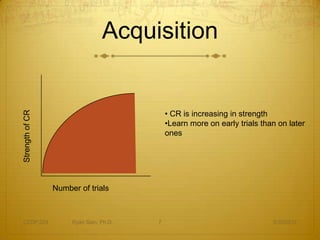324 03 part 3.1 classical conditioning mechanisms
- 1. Human Learning Topic 3: Part 3 Respondent Conditioning Mechanisms and Function CEDP 324 Ryan Sain, Ph.D. 1 3/30/2012
- 2. Contingency & Contiguity Contingency is a major key! the degree of prediction from the CS to the US effects the amount of conditioning Rescorla – p(us/cs) and p(us/no cs) Vary these probabilities using a 2 minute tone at random intervals .4 that the US would occur during a CS; .2 a US would occur during a no CS Contiguity also plays a role The shorter the ISI or TI the stronger the conditioning CEDP 324 Ryan Sain, Ph.D. 2 3/30/2012
- 3. Compound Stimuli Two or more stimuli occurring together (sound and sight - CR) then paired with a US Can test the effects of this by presenting one of the CSs alone after pairings Often you get conditioning to both But not always CEDP 324 Ryan Sain, Ph.D. 3 3/30/2012
- 4. Blocking Kamin – conditioned suppression procedure (css = light, tone, light tone; cr = shock) Two groups: blocking and control One stimulus seems to block conditioning to the other – no new predictability. Group Phase 1 Phase 2 Test Result Phase Blocking 1 Light Light/tone Tone Tone elicits no CR Control ------- Light/tone Tone Tone elicits CR CEDP 324 Ryan Sain, Ph.D. 4 3/30/2012
- 5. Overshadowing Intensity of the CS effects conditioning trials Loud CS and soft CS US = CR Test with either CS +CS = CR -CS ≠ CR But you can then use the –CS by itself and get conditioning One seems to overshadow the other CEDP 324 Ryan Sain, Ph.D. 5 3/30/2012
- 6. Experience with the CS Latent inhibition Presence of a CS in the absence of the US Delays acquisition in the future Prediction is decreased CEDP 324 Ryan Sain, Ph.D. 6 3/30/2012
- 7. Acquisition • CR is increasing in strength Strength of CR •Learn more on early trials than on later ones Number of trials CEDP 324 Ryan Sain, Ph.D. 7 3/30/2012







